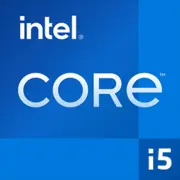Intel Core i5-3450S

Intel Core i5-3450S: Obsolete Warrior or Budget Option in 2025?
Architecture, Performance, and Considerations for PC Build Choices
1. Key Specifications: What Does Ivy Bridge Hide?
The Intel Core i5-3450S processor, released in 2012, belongs to the Ivy Bridge generation. It's a 22nm chip with 4 cores and 4 threads, a base frequency of 2.8 GHz, and a turbo boost of up to 3.5 GHz. With a TDP of 65W, it stands out as one of the most energy-efficient options of its time.
Key Features:
- No support for Hyper-Threading, which limits multitasking capabilities.
- Integrated Intel HD Graphics 2500 — suitable only for basic tasks (video playback, office applications).
- Turbo Boost 2.0 and Virtualization technologies improve responsiveness and virtualization.
Performance in 2025:
According to Geekbench 6, the i5-3450S scores 597 points in single-threaded tests and 1715 points in multi-threaded tests. In comparison, the modern budget Intel Core i3-12100 (2023) shows ~1800/6000 points. This indicates that the i5-3450S can handle office tasks and light applications but struggles with modern games or resource-intensive programs.
2. Compatible Motherboards: How to Make the Right Choice?
Socket: LGA1155 — an outdated standard, and new boards have not been produced since 2013. In 2025, finding a new motherboard is impossible, but you can find models on the secondary market:
- ASUS P8H77-V (used price: $30–50).
- Gigabyte GA-B75M-D3H (used price: $25–40).
Chipsets:
- H61, B75, H77, Z77. Overclocking (not possible with i5-3450S) requires Z77. The best choice for stability is B75 or H77 with support for SATA III and USB 3.0.
Selection Tips:
- Check the condition of capacitors on the used board — older models often suffer from bulging.
- Ensure that the BIOS is updated to the latest version for compatibility with NVMe SSDs (via PCIe adapter).
3. Supported Memory: DDR3 as a Limitation
The i5-3450S works only with DDR3 (up to 1600 MHz). Capacity is up to 32 GB (4 slots × 8 GB).
Issues in 2025:
- DDR3 is outdated: new modules are no longer produced, and prices for used ones start from $10 for 8 GB.
- No support for DDR4/DDR5: upgrading the system without replacing the processor and motherboard is impossible.
Tip: Use dual-channel mode (2 × 8 GB) to enhance performance by 10–15%.
4. Power Supply: How Many Watts Do You Need?
With a TDP of 65W and no overclocking, a PSU rated 400–450W is sufficient. However, consider other components:
- Dedicated graphics card (e.g., GTX 1650): +75–100W.
- SSD/HDD, cooling fans: +50W.
Recommendations:
- For a system with a GTX 1650, choose a PSU rated at 500W (e.g., Corsair CX550 — $60).
- For a PC without a graphics card, a low-powered PSU is enough (Be Quiet! SFX Power 3 400W — $55).
5. Pros and Cons: Is It Worth Getting in 2025?
Pros:
- Low power consumption (suitable for media centers).
- Adequate performance for office work and web surfing.
- Affordability (used processor — $15–25).
Cons:
- Outdated architecture: lacks support for AVX2, PCIe 3.0, USB 3.1.
- Limited upgrade potential: Socket LGA1155 is a dead-end platform.
- Weak iGPU: a discrete graphics card is necessary for gaming.
6. Use Cases: Where Is It Useful?
- Office Tasks: Word, Excel, browsers with 10+ tabs — the processor can handle this, but there may be delays with heavy PDFs.
- Multimedia: Streaming 1080p video, basic editing in Shotcut — rendering will take 2–3 times longer compared to an i3-12100.
- Gaming: Only older titles (CS:GO, GTA V) or indie games at low settings. With a GTX 1650 — 30–40 FPS in Fortnite (720p).
Real Experience: A Reddit user built a PC with an i5-3450S and GTX 1050 Ti for $150, playing Skyrim and Rocket League without issues.
7. Comparison with Competitors
- AMD FX-8350 (2012): 8 cores, but high TDP (125W) and weak single-thread performance (Geekbench 6 Single: 420).
- Intel Core i5-4570 (2013): A newer Haswell architecture, 15% faster, but more expensive (used — $30–40).
- Intel Core i3-10100 (2020): 4 cores/8 threads, supports DDR4. New — $80, but requires LGA1200 motherboard ($70).
Conclusion: The i5-3450S only wins on price but loses on performance and future potential.
8. Practical Tips for Building
1. Look for combos on the secondary market: Often, you can find a "motherboard + processor + RAM" bundle for $50–70.
2. Always install an SSD: A SATA SSD (e.g., Kingston A400 240GB — $25) will speed up the system.
3. Upgrade cooling: The stock cooler is noisy. Replace it with a DeepCool GAMMAXX 400 ($20).
4. Don’t skimp on the PSU: Cheap units can damage components.
9. Final Conclusion: Who Is the i5-3450S For?
This processor should only be considered in two instances:
1. Ultra-Budget Build: If you need a PC for document editing or browsing for $100–150.
2. Upgrading an Old Computer: Replacing a weaker CPU (e.g., Pentium G2020) without changing the platform.
Alternative: For a similar $150–200, you can build a system based on AMD Ryzen 3 3200G (used) with DDR4 support and modern technologies.
Conclusion: The Intel Core i5-3450S in 2025 is a choice for enthusiasts willing to deal with limitations for minimal investment. For most users, it’s wiser to invest in more modern platforms.
Basic
CPU Specifications
Memory Specifications
GPU Specifications
Miscellaneous
Benchmarks
Compared to Other CPU
Share in social media
Or Link To Us
<a href="https://cputronic.com/cpu/intel-core-i5-3450s" target="_blank">Intel Core i5-3450S</a>